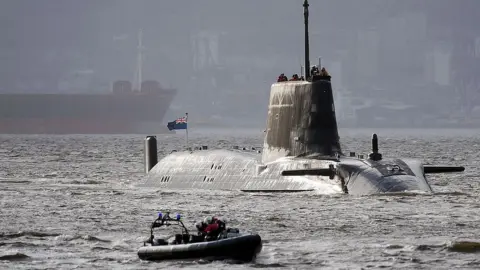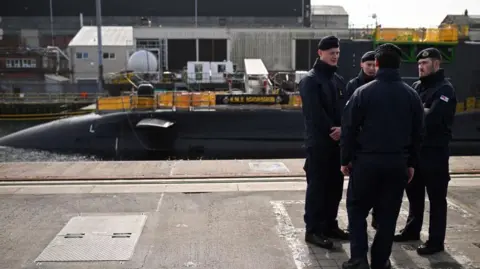Defence spending review marks significant turning point
 Getty Images
Getty ImagesDefence reviews come along quite regularly, mainly because governments struggle to fit their budgets to their ambitious commitments.
The UK tends to spend a bit on a lot of capabilities - at sea, in the air and on land, with an increasing effort in cyberspace.
In more than 30 years since the end of the Cold War, various governments have deployed the reduced defence spending dividend on other priorities, from tax cuts to the health service.
But this announcement marks a turning point. This spending review looks to be far more significant than any we have seen for decades.
For a start, ambitions seem to be getting narrower, focussed on the 'Euro Atlantic' area. That is a change from the last review's tilt towards being a power player in waters around Asia.
One of the Royal Navy's aircraft carriers is currently flying the flag in that arena, as tensions rise between China and Taiwan.
But this review, led by Lord George Robertson, who has served as a Scottish Labour MP, defence secretary and secretary-general of the NATO alliance, is patching up some big gaps much closer to home.
The emphasis is on a shift to combat readiness, which means stepping up preparations for war with an estimate that a Russian attack on NATO could come in two or three years.
The emphasis is also on the industrial capacity that lies behind that fighting machine.
Because of stop-start funding and buying in batches instead of funding private companies to continue production of weapons systems, Britain lacks the ability to sustain its front line operations.
 Getty Images
Getty ImagesOne of two big lessons to come out of the war in Ukraine is that prolonged battles along a front have not been consigned to 20th century history.
Russia has attacked and is willing to sustain vast costs, casualties and economic sanctions, turning over much of its manufacturing to the war effort and assuming that Ukraine and its allies will run out weapons or patience before the Kremlin does.
The other big lesson points in the opposite direction to old forms of warfare and to new forms of fighting - in particular drones.
After the first year or so in the battle over Ukraine, new tactics emerged in which both sides deployed simple drones to devastating effect.
It has not been enough to procure them - the next stage is the technological battle to jam them and to overcome that jamming.
Ukraine and Russia have reminded us that war drives innovation at a rapid pace.
So in preparing for war, the UK's forces need to understand how to use and deter drones, but also how to change tactics and innovate quickly.
Some of these lessons are getting a response from the UK Government. It needs to have an 'always-on' industrial capacity for backing up munitions and energetics - the propellants and explosives that go into them.
 Getty Images
Getty ImagesPerhaps the most important response in the review in the Scottish context is the promise for more attack submarines, which will be nuclear-powered but conventionally armed, to replace the seven current Astute class subs "from the late 2030s".
That's on top of the commitment to replace the four Trident missile armed Vanguard fleet with the new Dreadnaught class subs.
That could bring more activity to the Clyde, where all the Royal Navy's subs are based.
More conventional long-range missiles bring a deterrent far short of nuclear attack and support 800 jobs.
The prime minister, defence secretary and Scotland secretary are all emphasising the impact this could have on jobs, the economy and growth, promising tens of thousands of jobs and apprenticeships.
Meanwhile, the use of such missiles by an adversary raises questions about the UK's very limited anti-missile defences.
Better quality Ministry of Defence housing won't improve fighting capability directly but it helps with recruitment and retention of those in uniform, which is a significant problem in a tight labour market.
Lord Robertson's review can be expected to cover much more than the issues so far fed to us by the government, to get the headlines it wants.
There are awkward issues around the amount of money that will be required to step up to battle readiness.
The plan is for 2.5% of annual national output soon, and 3% by 2034, but that's a long wait and is unlikely to meet expectations.
 Getty Images
Getty ImagesThere are also undiplomatic questions to be asked about the role of the USA as an ally.
Can America be relied upon to continue holding a nuclear defence umbrella over Europe? Without it, the UK and France - the other two Nato nuclear powers - would have to step up and fill that vacuum.
We're told that a lot of effort and spending is going into stepping up Britain's warhead-making capacity, at Aldermaston in Berkshire.
It is not yet clear if this is because the US can no longer be trusted to supply the weapons.
It may be that this is because there seem to be moves to deploy nuclear missiles on Royal Air Force aircraft, in addition to Royal Navy subs.
Either way, there are controversies there for the Labour government. Its own side includes strong opposition to nuclear weapons, notably in the Scottish party.
The SNP has been consistent in its opposition to nuclear weapons, and that has been repeated by John Swinney.
The first minister would prefer to spend more on conventional weapons and see a relaxation of spending constraints at the treasury in order to avoid collateral damage to other public spending.
The military threat is putting even more pressure on the chancellor to find ways of softening that hard ceiling on borrowing, and to do so in the looming spending review.
